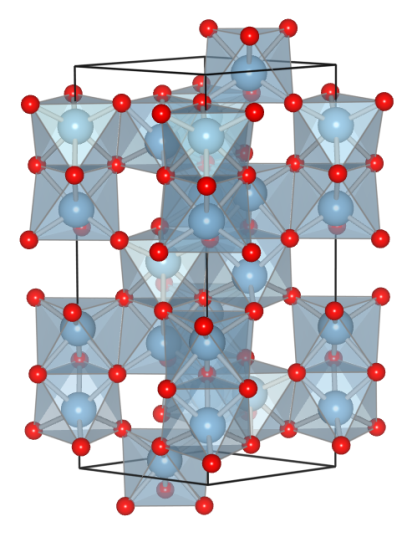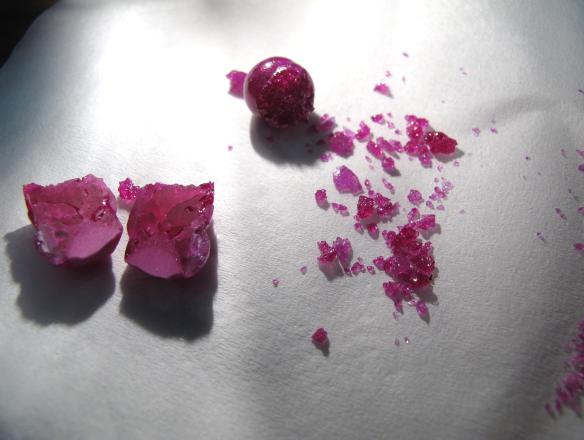This month introduces us to the most iconic of red gems: Ruby, the birthstone of July
What is a ruby?
Trick question – rubies don’t exist! Well, they do, though technically they are no more than red sapphires. Both ruby and sapphire are names given to gem-quality stones of the mineral corundum (Al2O3). Although the word "sapphire" is commonly used to imply blue gems, it can also be used to refer to the whole range of coloured and colourless corundums (from green or yellow to peachy-orange and purple), while "ruby" refers strictly to red or pink stones. Sapphire will be blogged later this year as the birthstone of September.
The crystal structure of corundum consists of aluminium atoms surrounded by six oxygen atoms in a slightly irregular "octahedral" shape. Each oxygen atom is shared between four of these octahedra – some of which are joined at the corners, some along edges, and some on the faces – so that the ratio of aluminium to oxygen atoms is 2:3.

The corundum structure of ruby (and other sapphires). Blue spheres: aluminium; red spheres: oxygen. (ICSD-10425; drawn using VESTA)
Pure Al2O3 is colourless; the many colours it displays in nature are caused by trace metal impurities. Rubies are red due to the presence of chromium, while blue sapphires contain tiny amounts of titanium and iron. Rather than occurring as distinct chunks or particles distributed through the crystal, these metals are actually incorporated into the crystal structure on an atomic scale – meaning that a percentage of the aluminium atoms are simply replaced by the impurity element at random points throughout the whole crystal. (A strongly coloured red ruby might have about 1% of its aluminium replaced with chromium.) This kind of atom-for-atom substitution is known as a "solid solution", because the corundum structure can be thought of as a liquid that "dissolves" an impurity. Of course, dissolving a metal in a gem requires far more energy than dissolving a sugar cube in water! This is why rubies and many other solid solutions are only formed at very high temperatures, such as those found under the earth.
Natural ruby has been known and valued for its ornamental uses since ancient times, though many red gemstones were indiscriminately termed "rubies" before scientific tests allowed man to distinguish between true rubies and other red gems. Rubies have historically been mined in parts of south Asia (Afghanistan to Sri Lanka), Africa, Australia, and south-east Asia, especially Myanmar, from which the richly-coloured but gorily-named "pigeon's blood" rubies originate. (Pigeons evidently have redder blood than the rest of us!) The largest mined ruby in the world, the Liberty Bell Ruby, was stolen in a high-profile heist in 2011 and remains unrecovered.
In addition to its aesthetic appeal, ruby finds important technical applications as a laser material, so optical-quality specimens remain in high demand. The majority of laser rubies are now grown synthetically, often using the Vernueil flame-fusion technique, though hydrothermal or melt-crystallisation methods (Czochralski, floating-zone growth) can also be employed.

Here’s one I prepared earlier … Synthetic ruby (1% Cr) grown by the floating-zone method.
Where does the structure come from?
William and Lawrence Bragg (the father-and-son team of Nobel Prize and crystallographic Bragg's Law fame) studied the structure of corundum in 1917. Although they correctly predicted the formula Al2O3 and the six-fold coordination of aluminium, many of their proposed bond lengths were inaccurate. Linus Pauling and Sterling Hendricks published the corrected corundum structure in 1925.






